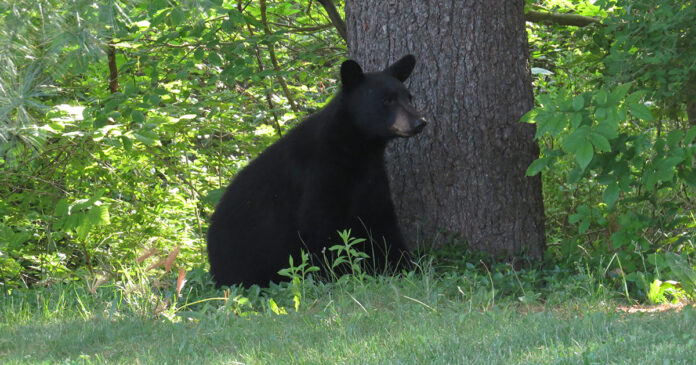A typical encounter with a black bear in Virginia goes something like this: you hear a rustle of leaves and then glimpse a patch of black fur as a large animal shuffles off into the dense underbrush of the forest.
Now researchers in the College of Natural Resources and Environment are gaining a closer look at our elusive neighbors and sharing some of their findings with the public, both on social media and in a new exhibit at the Mill Mountain Zoo in Roanoke.
The newest bear necessity: video cameras
VIDEO:https://video.vt.edu/media/1_l69qfu1k
The research project on bear behavior, led by Professor Marcella Kelly of the Department of Fish and Wildlife Conservation, involves putting collars mounted with small video cameras on 19 black bears to provide a snapshot into the day-to-day moments of a bear’s life.
“Every 20 minutes the camera takes 20 seconds of video,” said Kelly, an affiliate of the Fralin Life Sciences Institute. “At that rate, we’re able to get about two months of data from each bear, which tells us a lot about their behaviors and particularly about their diets that we couldn’t get from stomach content or scat analysis.”
Master’s student Brogan Holcombe, who previously managed Kelly’s Wildlife Habitat and Population Analysis Lab, said that the information they’re collecting is offering new insights into bear behavior as well as providing information about broader land management concerns.
“In the central Appalachian Mountains, there’s been a decrease in the deer population in recent years,” Holcombe explained. “One of the questions we’re looking into is whether or not bears are impacting that decline and how. Are black bears scavenging deer carcasses, are they actively looking for fawns when they drop in early June, or is it something else?”
The research is part of the broader Virginia Appalachian Carnivore Project, led by Kelly, which is studying the predator-prey dynamics of bears, coyotes, and bobcats. By placing GPS collars on predators and then monitoring when they cluster around a dead animal, researchers are able to go out into the field and perform forensic analysis to determine how the prey species died.
“Bears are a challenge because they gobble up food quickly, so we couldn’t answer a lot of questions about their eating behaviors by searching their clustered locations,” Kelly noted. “We pitched the idea of putting cameras on bears, and the Safari Club International and Acorn Alcinda Foundation provided funding for the camera collar project.”
While camera footage of bears enjoying meals of fresh venison tend to get the most attention, the collected footage also has the potential to inform land management considerations around invasive plant species in the region.

“In our preliminary analysis of just a few bears, we’ve noticed that the females tend to eat the invasive wineberry, while the one collared male appeared to prefer the native huckleberry and blueberry,” Holcombe said. “As female bears tend to have smaller home ranges, we don’t know if they’re significantly spreading wineberry, but it’s something that we’re keeping separate in our analysis to provide information to state officials for their research into this invasive plant.”
Connecting research to the public
Some of the footage that Kelly and Holcombe have collected of bear foraging behavior, as well as video that Kelly collected previously on captive bears, is getting a public showing courtesy of Professor Sarah Karpanty. Her conservation biology senior capstone class in the Department of Fish and Wildlife Conservation used some of the footage to create educational videos about black bear behavior for the Mill Mountain Zoo to share with visitors.
“This was a terrific opportunity for our students to bring together Dr. Kelly’s amazing research with the conservation mission of the Mill Mountain Zoo,” Karpanty said. “Conservation biology involves a lot of interaction and outreach with the public, and this was a great opportunity for our students to do that kind of hands-on work of engaging and educating people.”
Karpanty’s students also gained practice in utilizing state-level policy to better inform the public: the voiceovers in the videos communicate information about the state’s black bear management plan, developed by the Virginia Department of Wildlife Resources.
Holcombe, who shares some of the black bear videos on Twitter with the hashtag #BearsEyeView, said that social media is another area where wildlife researchers are finding traction engaging with the public. The hashtag even got the attention of Backpacker Magazine, which ran a story about the project.
“Posting new videos gets people excited and engaged in something that might otherwise feel like it’s happening somewhere else,” said Holcombe, who has also used social media to get help identifying some of the lesser-known plant species and even some insects that the bears are eating. “Through the use of these platforms, we can create a storyline of the research we’re doing, which allows people to scroll through our work in real time.”
For Kelly, who also runs a long-term jaguar monitoring project in Belize, the success of the bear cam footage has the potential to open new avenues for monitoring animal behavior for other species.
“The video quality was remarkably high, so much so that we were able to do a more detailed profile of the bears’ diet than I initially expected,” she said. “While there are still challenges to work through regarding the weight of camera batteries, I can imagine a future where we’ll be able to replicate this kind of monitoring with coyotes or bobcats, and even on deer.”

